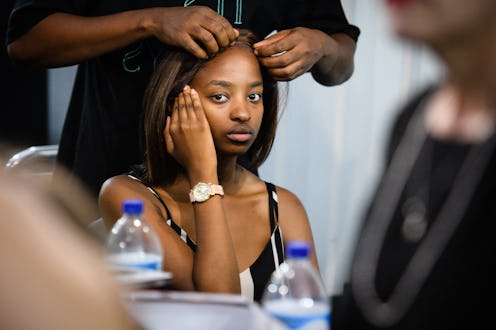Style
Women Of Color Have High Levels of Toxic Chemicals In Their Bodies & Racist Beauty Standards Are To Blame

Yet another sign of racism and inequality comes to you from your cosmetic cabinet. According to a new research published by the American Journal of Obstetrics and Gynecology, women of color have higher concentrations of beauty product-related chemicals in their bodies than white women do.
"And water is wet," you might be inclined to say in reaction to these findings. That response is in no way shaming this vital research which puts attention on important issues of inequality. Rather it's a sad knee-jerk reaction to unfortunate, angering, and expected racial injustice in our society — and especially in the beauty industry.
The report, titled "The Environmental Injustice of Beauty: Framing Chemical Exposures from Beauty Products as a Health Disparities Concern," was co-authored by Ami Zota, ScD, MS, an assistant professor of environmental and occupational health at the Milken Instititute School of Public Health at the George Washington University, and Bhavna Shamasunder, an assistant professor in the Urban and Environmental Policy Department at Occidental College.
The paper explains that chemical exposure levels in women of color are astronomically higher than those in white women, and that high levels of cosmetic chemicals in one's system can lead to poor reproductive health and poor general well-being.
The fault for this racial disparity, according to the paper, hinges on unrealistic beauty standards that favor Western ideals and whiteness.
"Racial discrimination based on European beauty norms can lead to internalized racism, body shame, and skin tone dissatisfaction, factors that can influence product use to achieve straighter hair or lighter skin," explains the commentary, which also condemns the marketing that takes advantage of this inequality. "Pressure to meet Western standards of beauty means Black, Latina and Asian American women are using more beauty products and thus are exposed to higher levels of chemicals known to be harmful to health."
The effect of Western beauty standards on women of color does, of course, vary from person to person. But the commentary does detail some ways in which beauty pressures have impacted many women of color, from dangerous mercury-containing skin-lightening creams, to hair relaxers and straighteners which have been linked to adolescent health issues and a higher risk of breast cancer.
The commentary even delves into less talked of problems, like how Black women are much more likely to both douche and apply baby powder to their genitals than white women. These harmful "beauty routines," the paper explains, tie into racist stereotypes that characterize Black women as "unclean."
Douching exposes users to diethyl phthalate, a chemical known to cause reproductive health issues, while also increasing risk for bacterial infections. And even baby powder, which you'd think would be safe, may be linked to ovarian cancer (though studies are so far inconclusive).
With these alarming findings, there's no easy answers on where we go from here. But it's important that we talk about beauty standards, cosmetic chemicals, and racism to promote the health and well-being of women of color around the globe.